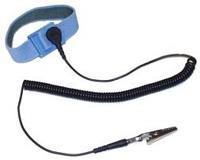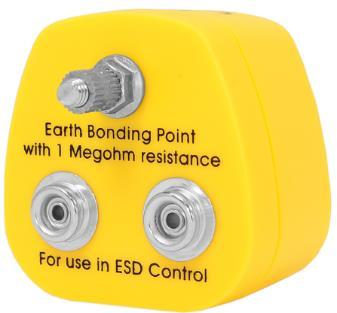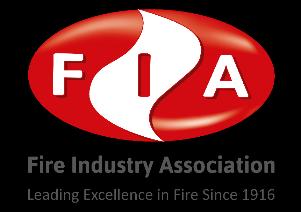Guidance Note

Guidance on antistatic precautions when fitting equipment to control and indicating equipment
1. INTRODUCTION
This technical communication is to advise members of the implications and precautions to be used when changing Printed Circuit Board Assemblies (PCBA’s) in Control and Indicating Equipment (CIE) in a field application.
2. PROTECTION AGAINST ELECTROSTATIC DISCHARGE (ESD)
CIE products that have the CE marking are designed and evaluated for immunity to international Electrostatic Discharge (ESD) standards. While these products have been designed and determined to be compliant with standard levels for ESD, there may be situations, such as low humidity levels, that can exacerbate an ESD event occurrence.
It should be noted that ESD compliance tests are applied to the exterior of the CIE. No testing is applied directly to the internal circuits. Therefore, ESD precautions must be taken when work is conducted on the internal circuits of the CIE.
Electrostatic discharge (ESD) events can harm electronic components inside CIE Under certain conditions, static electricity may build up on your body or an object, such as a peripheral, and then discharge into another object, such as the CIE. To prevent ESD damage, you should discharge static electricity from your body before you interact with any of the CIE’s internal electronic components, such as a motherboard, loop cards, display boards, printers, etc…
You can protect against ESD and discharge static electricity from your body by touching a metal grounded object (such as an unpainted metal surface on your CIE’s panel) before you interact with anything electronic. When connecting a peripheral to your CIE, you should always ground both yourself and the peripheral device. In addition, as you work inside the CIE, it is good practice to periodically touch a metal-grounded object to remove any static charge your body may have accumulated.
You can also take the following steps to prevent damage from electrostatic discharge:
• When unpacking a static-sensitive component from its shipping carton, do not remove the component from the antistatic packing material until you are ready to install the component. Just before unwrapping the antistatic package, be sure to discharge static electricity from your body.
• When transporting a sensitive component, first place it in an antistatic container or packaging.
• Where possible, handle all electrostatic sensitive components in a static-safe area.
• If possible, use antistatic floor pads and work bench pads.
2.1 Before working inside the CIE
1. To help avoid the potential hazard of electric shock, do not connect or disconnect any cables or perform maintenance or reconfiguration of your equipment during an electrical storm.
2. Shut down the CIE, disconnect the main power supply and batteries.
3. Disconnect the CIE and all attached devices from their electrical outlets.
4. Disconnect all attached network devices and peripherals
NOTE
Before working inside your CIE, read the safety information that is shipped with the CIE. Disconnect all power sources before opening the CIE cover or panels
CAUTION
Before touching anything inside the CIE, ground yourself by using a wrist grounding strap or by periodically touching an unpainted metal surface.
To avoid damaging any components, ensure that the work surface is flat and clean.
Handle components and cards with care. Do not touch the components or contacts on a card. Hold a card by its edges or by its metal mounting bracket. Hold a component such as a processor by its edges, not by its pins.
When disconnecting cables, always pull on the connector or the pull tab, never on the cable itself. Some cables have connectors with locking tabs or screws that need to be disengaged before removing the cable. For ribbon cables, ensure the locking mechanisms are released, and handle the connectors with care. When disconnecting and reconnecting any cables, keep them aligned to avoid bending pins, and ensure ports and connectors are correctly oriented.
2.2 While working inside the CIE and handling sensitive components
To ensure safety when working inside the CIE, follow these steps to prevent static electricity damage:
1. Wear an anti-static wrist strap: This is our primary recommendation.
2. If you don't have a wrist strap: Ground yourself before touching anything by touching an unpainted metal surface.
3. While working: Whether wearing a wrist strap or not, periodically touch an unpainted metal surface to dissipate any built-up static electricity.


2.3 After working inside the CIE
1. Replace all screws and ensure that no stray screws remain inside your CIE.
2. Connect any external devices, peripherals, or cables you removed before working on your CIE.
3. Connect your CIE and all attached devices to their electrical outlets.
4. Turn on the CIE.
CAUTION
Leaving stray or loose screws inside your CIE may severely damage your CIE
NOTE
After you finish working inside the CIE, replace all covers, panels, and screws before connecting to the electrical outlet.
2.4 General power safety guidelines
• Check the voltage rating before you connect the equipment to an electrical outlet to ensure that the required voltage and frequency match the available power source.
• Your device is equipped with either an internal power source or an external adapter. For internal power sources, your device is equipped with one of the following:
o An auto-sensing voltage circuit – Devices with an auto-sensing voltage circuit do not have a voltage selection switch on the back panel and automatically detect the correct operating voltage.
o Or a manual voltage selection switch – Devices with a voltage selection switch on the back panel must be manually set to operate at the correct operating voltage. Set the switch to the position that most corresponds with the voltage used in your location.
CAUTION
To help avoid damaging a CIE with a manual voltage selection switch, set the switch for the voltage that most corresponds with the AC power available in your location.
Guidance on antistatic precautions when fitting equipment to control and indicating equipment
3. REFERENCES
Radio Equipment Directive 2014/53/EU
Low Voltage Directive 2014/35/EU
Construction Products Regulation EU 305/2011
UK SI 2013 No. 1387 Building and buildings, The construction products regulations 2013
UK SI 2016 No. 1091 Electromagnetic Compatibility, The Electromagnetic Compatibility Regulations 2016
UK SI 2016 No. 1101 Consumer Protection Health and Safety. The electrical equipment (Safety) Regulation 2016
BS 5839-1: Fire detection and fire alarm systems for buildings
EN 54-2: Fire detection and fire alarm systems – Control and indicating Equipment
EN 54-4: Fire detection and fire alarm systems – Power Supply Equipment

Guidance on antistatic precautions when fitting equipment to control and indicating equipment • Version 1 • March 2024 • Tel: +44 (0)20 3166 5002 • www.fia.uk.com
